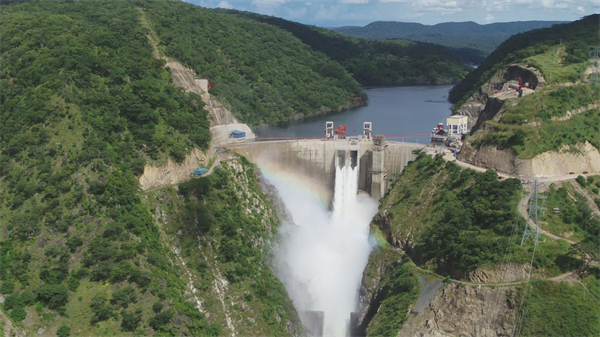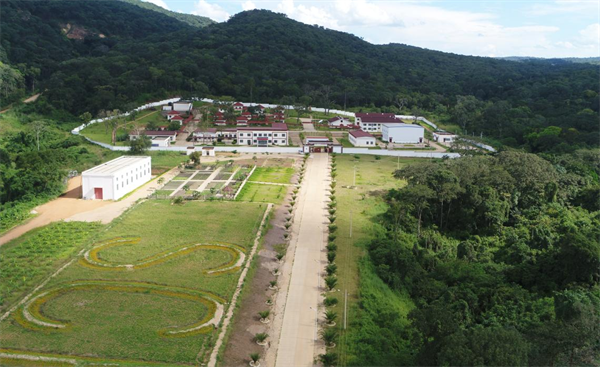Fourteen-year-old Jenny, living in a village in the Busanga Canyon, Lualaba Province of the Democratic Republic of the Congo (DRC), expressed her thanks to the Chinese builders of the Busanga Hydropower Station with excitement when they revisited her school.
The hydropower station Jenny mentioned is located in downstream reaches of the Lualaba River and was invested, built and operated by China Railway Resources Group Co., Ltd, a subsidiary of China Railway Group Limited (CREC).
It is the first hydropower station in the country that was built to Chinese standards with Chinese equipment and Chinese technologies.
The station is also the only one of its kind to adopt the BOT commercial operation mode in the country and the largest in the Greater Katanga Region in the past 66 years.

A view of the dam of the Busanga Canyon, Lualaba Province of Democratic Republic of the Congo [Photo/sasac.gov.cn]
A modern green hydropower station
Jenny's father is one of the employees working for the Busanga Hydropower Station project and has participated in the entire progress of the construction and operation of the station.
He expressed his thanks to the Chinese side for bringing them a modern and green hydropower station.
It was to his surprise that the Chinese builders so highly-value the environmental protection.
He said that the construction of the project started in 2017 and about 60 to 70 among the hundreds of Chinese management personnel and building teams were responsible for security and environmental protection.
What's more, the Chinese builders specially made landscape and plant restoration plans at the living and office site, the roads on both banks of the river and the reservoir area.

A view of the site of the project operation department of the Busanga Hydropower Station [Photo/sasac.gov.cn]
Zhao Wenguang, deputy general manager of China Railway Resources Group Co., Ltd and head of the project construction, said that ecological resources are treasure for every corner of the world.
The Chinese builders widely used the green and advanced dam concreting technologies, intending to protect the original ecology and restore the environment.

A view of the green mountains on both sides of the downstream of the Lualaba River [Photo/sasac.gov.cn]
With a total installed capacity of 240 megawatts, the Busanga Hydropower Station is capable of generating 1.32 billion kilowatt-hours of power annually, equaling that produced by burning 447,000 metric tons of standard coal and constituting a reduction of 1.1 million tons of carbon dioxide emissions.
If the station is to run for 50 years, it is expected to reduce consumption of 22.35 million tons of standard coal and cut down emissions of 55 million tons of carbon dioxide.
"We will build an ecological corridor on the bank of the ancient Lualaba River and a green landscape hydropower station," the Chinese builders said, and they kept their promise.
Getting stable income
"We no longer need to worry about the power shortage of our factory and the output has been doubled. The improving production efficiency guarantees our income," said a local security and environment engineer at a mining exploration and production enterprise in Lualaba.
According to him, power shortage was once a bottleneck of the production of the enterprise.
Operation of the Busanga Hydropower Station helps relieve the power shortage and drives development of the mining industry, benefiting local people and boosting the country's economic and social development, said the general manager of Gecamines, state mining company of DRC.
Improving local livelihoods
The Busanga Hydropower Station project has provided jobs for local people. During the peak construction period, more than 3,000 local people were recruited. Jenny's father was hired by the project as a driver and deputy head of the security department.
In addition, the project also helped the region cultivate talents with professional technical skills.
The head of the country’s Ministry of Water Resources and Power said that the project has driven regional economic development, helped relieve energy shortages in affected areas and contributed to local employment and livelihood improvement. The company contracting the project also fulfilled social responsibilities. It is a model of China-DRC cooperation and a symbol of the two countries' friendship.
During construction of the station, more than 7,000 people were moved to a new relocation village equipped with schools, a hospital and drinking water wells, which greatly improved their living conditions.
According to Zhao, the company also invested more than $8 million to renovate roads and bridges to guarantee construction of the project while easing travel for local people.
(Executive editor: Xie Yunxiao)